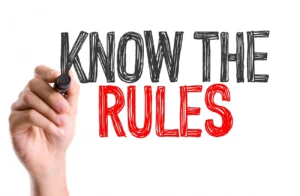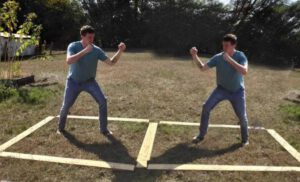 Part of an ongoing series of 5e Rules notes.
Part of an ongoing series of 5e Rules notes.
There are a number of rules that deal with the basic question of “How do I get past that guy?” Note that all the below are caveated by class or racial powers that may say otherwise. Monks and rogues and some smaller creatures get special abilities to do some of this stuff.
Note also that if you use any of these, you still run the risk of an Attack of Opportunity if, once past, you continue running beyond someone’s reach.
Also, if the either of the opponents here is one of those that does damage to a melee attacker “within five feet,” I would as DM incur that penalty to these maneuvers as well (even if they are not, strictly speaking, melee attacks). In other words, if you are shoving, shoving past, or even tumbling around that flaming guy, you’re going to get burned (and if it’s the flaming guy trying to move through, the target’s going to get burned, regardless of whether the attempt was successful).
The Magic of the Five Foot Square

Okay, if you are doing Theater of the Mind, more power to you. I run on a 5-foot square grid.
Obviously a Medium creature (as most players and many opponents are) does not fill the entire square, like some sort of gelatinous cube. Instead, the square represents what war-gamers would call a “zone of control.” A player in a 5-foot square can be anywhere (and, in a sort of quantum fashion, everywhere) within it. Even if you are leaning waaaaaaaay over to one side to shoot arrows at that goblin behind partial cover, you are still blocking that orc from traipsing through the other side of your 5-foot square.
The basic rules of 5e (and D&D in general) is that, with some identified exceptions and weird edge cases, opposed beings cannot occupy the same 5-foot square. So, other than slaying that enemy in your way, how can you get past them?
Here is a summary of the ideas spelled out below …
| If you are _____ than your opponent … | … then consider _____. |
|---|---|
| Bigger | Overrunning |
| Bigger (a lot) or Smaller (a lot) | Moving Through |
| Stronger | Shoving, Shoving Aside, or Overrunning |
| More Agile | Tumbling Past |
Moving Through
You can move through a hostile creature’s space only if the creature is at least two sizes larger or smaller than you. Remember that, even in those cases, another creature’s space is Difficult Terrain for you.
Cost: Difficult Terrain movement.
Shoving
There are a couple of possibilities here — a bog-normal Shove attack, or an optional Shove Aside.
Note that in neither case do you need to worry about “Difficult Terrain” as you are never deemed to be in the same square as the enemy (don’t think about it too hard).
If we think of You (Y) doing one of these attacks against the Enemy (E), here is where they would end up with a Shove (S) or an (optional) Shove Aside (A)
S S S A E A Y
Shove
You can use a Shove as an attack in the round, pushing the target away from you 5 feet (think of the offensive line in a football game). Once you push them away, you can step into their space and then beyond.
“Away” on a square grid would be straight back or diagonally back. (The DM might want to opine on that one, but Jeremy Crawford says diagonal counts as “away”. More discussion here.)
For a Shove, the target can’t be more than one size larger. You as the shover make a Strength (Athletics) roll vs. their (choice of) Strength (Athletics) or Dexterity (Acrobatics).
You could also knock them Prone with a Shove attack but that doesn’t clear out the space for you to move through.
Cost: One Attack.
Shove Aside
This is an Optional Rule on DMG 272: Rather than using a Shove to move someone back (or Prone), you use Shove to move them to the side.
Essentially, this is a more difficult Shove attack, with the same skill comparison, so you as the shover roll at Disadvantage. If successful, the opponent is shoved 5 feet to the side, meaning you can move through their square at no additional movement penalty.
As a DM, the added difficulty seems quite fair and I wouldn’t hesitate to allow this optional rule.
Cost: One Attack.
Tumbling Past
This is an optional rule, so check with your DM first. DMs, this can provide color, but it can also make your sneaky rogue types (who probably have a high DEX) a lot more dangerous.
This can be found in the DMG, page 272: As an Action or Bonus Action, you do a Dexterity (Acrobatics) vs Dexterity (Acrobatics) check; if you win, you can move through the hostile creature’s space (as difficult terrain).
There’s no specific penalty for failure here — except that you’ve burned an Action or Bonus Action, successful or not.
Costs: Action or Bonus Action; Difficult Terrain movement.
Overrunning
Yet another optional rule, on DMG page 272, this is basically just shoving your way past the opponent (or using your Strength to do a Move Through).
As an Action or Bonus Action, you roll a Strength (Athletics) check vs the defender’s Strength (Athletics). You are at Advantage if of a larger size, or Disadvantage if of a smaller size. If successful, you can move through the square (as Difficult terrain).
Cost: Action or Bonus Action; Difficult Terrain movement
But what about Jumping Over them?
The Jumping rules really don’t allow this. Or don’t work well with it.
First, High Jumps don’t help, since they are only up-and-down, according to the rules. (Yes, Olympic High Jumps involve some horizontal distance, though often not much, I don’t think anyone is envisioning jumping backwards over an orc and then landing on their own back on a huge fluffy pad.)
Second — this is not an easy thing to do. Even under highly controlled non-combat situations.
You just can’t jump high enough on a Long Jump to reliably get over an opponent’s head. The height you achieve on a Long Jump, with a successful Strength (Athletics) check vs DC10, is (distance/4) feet; assuming the space a Medium creature controls space is not just 5×5, but 5x5x5, you would need a distance jumped of 20 feet (20/4=5) to get past them (i.e., with a Running Long Jump, that means you’d need a STR of 20).
Magic might help: a Jump spell (or Ring of Jumping) triples your jumping distance, thus your someone with a STR of, say 16, would theoretically be able to Jump 48 feet, clearing 12 feet high …
… although that the irritating Jumping rules still, even with a spell, restrict your Jumping distance to your Speed. If your speed is 30, you can only jump 30 feet (or 20 if you are doing a Running Long Jump that takes a 10 foot run-up). That still lets you clear that 5 foot height (20/4), and it means you only need a Strength 10 to (barely) jump over an opponent. (Speed magic would help here even more.)
That said … is a 5 foot height being the vertical control zone actually a real thing? Eh … given that D&D tends to be a bit vertically challenged in terms of accommodating things that are above ground level, you could argue it for most Medium characters (esp. as weapons and armor aren’t generally pointed at / oriented toward / limber regarding upward attacks). If you remember the Golden Rule that D&D is not a physics simulator (it’s not even a combat simulator), it kinda-sorta works fine.
Since you would be flying over the enemy’s head, there is no Difficult Terrain consideration. Thank goodness for that.
Taller creatures will tend to be Large in Size, and thus fill up (or control) a 10-foot square space (a lot more to jump over), but even if they don’t, maybe the best way to handle it is with a higher DC on that Strength (Athletics) check (DM discretion).
What does happen if that Strength (Athletics) check to jump over something fails? In theory, just as with a non-opponent Long Jump, the jump fails at that point, and you end up, probably Prone, in the square in front of the enemy you tried to jump over. But we’ll leave those esoterica as an exercise for the student.
But Don’t Forget …
Sliding past/under, or jumping up-over, a bad guy is a pretty bad-ass cool move, the sort of thing that will have characters (or their players) bragging about over beers for months or years to come.
Which means, on an exceptional basis (e.g., in a boss fight) the DM should probably be willing to bend the rules at least a bit to allow such an attempt, even of the numbers don’t quite work out. The rules are there to let you know what should normally work and what normally shouldn’t. But ultimately, that judgment belongs to the DM — and a balls-to-the-wall unexpected heroic attempt … should get at least a bit of latitude.
